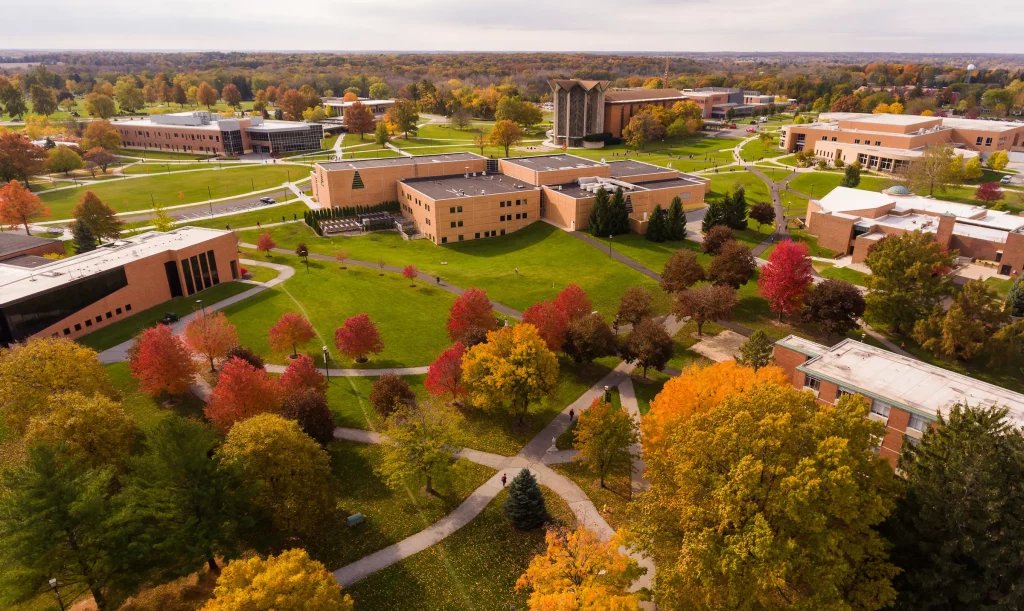Using the Sun to Clean up the Atmosphere
Valparaiso University prides itself on the opportunities it provides students to use their learning to serve a greater cause. The University is also committed to sustainability, and keeping the planet as clean and healthy as possible. A new grant from the United States Department of Energy has given Valpo a chance to live those values.
The International Panel on Climate Change (IPCC) has concluded that to meet temperature goals in the coming years, we must go beyond lowering our carbon emissions and seeking alternate fuel sources — we must also develop ways of removing carbon dioxide already in the atmosphere. A grant from the Department of Energy given to Carbon Solutions, LLC will be used to research carbon dioxide removal and storage, and the company has turned to researchers at Valparaiso University’s James S. Markiewicz Solar Research Facility to help.
Carbon Solutions, LLC creates software tools to help companies assess optimal ways to capture CO 2 from the air using Direct Air Capture (DAC) units, transporting that Co2 to storage sites, and safely storing the CO 2 underground.
“Geothermal and solar resources are different around the country,” says Jonathan Ogland- Hand ’14, Ph.D, an alumnus of Valpo’s mechanical engineering department, director of energy systems analysis at Carbon Solutions, LLC, and leader of the company’s Department of Energy-funded project. “We’re creating software to provide decision support for project developers building these machines to identify where they should build and what resources they should use.”
The process of capturing the CO 2 requires pumping hot, salty water — called “brine” — out from under the ground and into the DAC unit. The energy in the hot brine is released to drive out the CO 2 , but the brine is not quite hot enough straight from the ground. It must be heated further in-transit, which is where Luke Venstron ’07, Ph.D., associate professor of mechanical engineering and Paul H. Brandt professor of engineering, and his student researchers will assist in the project.
“Valpo has a lot of expertise in solar energy research. I thought it would be a great partnership,” Jonathan says. “The whole purpose of these machines is to take CO 2 out of the atmosphere, so if you emit CO 2 to get that energy, you’re defeating the purpose. You need a carbon-neutral source of energy, and the sun is one of those.”
For Valpo, the project fits perfectly with its commitment to stewardship of the planet, and using engineering knowledge to create a better world.
“This is a sustainability project. It is about as direct a project about addressing climate change as you can get,” says Professor Venstrom. “It’s not about energy efficiency, it’s not about alternative sources of energy, it’s about solving the problem that is the carbon dioxide already in the atmosphere. It’s an issue that the international panel on climate change has demonstrated must be addressed.”
Beginning in April and continuing for two years, Professor Venstrom and student researchers will look into the most efficient means of implementing a solar-powered heating system, but while using sunlight to make heat may be an elementary task, other roadblocks may complicate the design of a functional system.
“The challenges I’m seeing are wonky engineering things,” Professor Venstrom says. “The platform that Carbon Solutions is developing is based off of this software package called IDEAS, which is a tool for engineering calculation. I’ve never used it before, so there will be some learning curve challenges.”
Beyond the learning curve, the brine itself presents a challenge in regards to potential corrosion, which will require careful consideration towards what pipes, pumps, and brines will combine to create the most efficient device.
“What are the modifications that have to be made? How do they adjust the cost? All of these are questions that we’re trying to answer,” Professor Venstrom says.
Students hired to assist with the project will use everything they’ve learned in their heat transfer class and work with the solar lab to help bring the project to life. Their work will focus on creating system models that will allow them to calculate the temperature of brine entering a pipe compared to its temperature upon exiting.
DAC units are not an entirely new technology, but their potential use has seen a major upswing since the IPCC released its findings on the urgency for CO 2 removal. Those findings — and the response from participating governments — may drive wider usage of the technology.
“I think a lot of companies that are getting involved in this space are anticipating more funding coming out to subsidize these types of technologies,” Professor Venstrom says.
To learn more about how engineering at Valparaiso University is working to change the world, visit valpo.edu/engineering. To learn more about what you can do to help create a more sustainable community, visit valpo.edu/sustainability.

